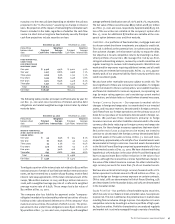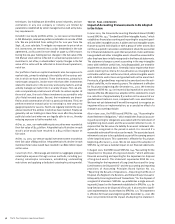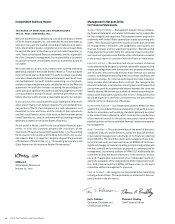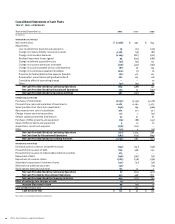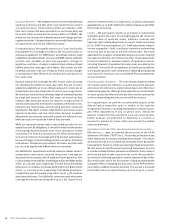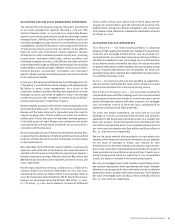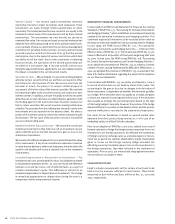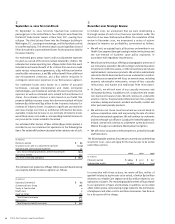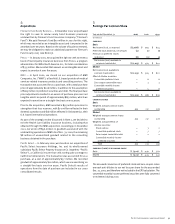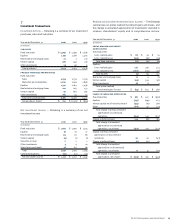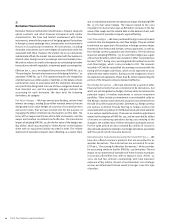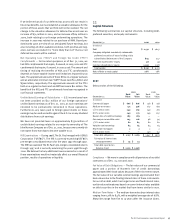Travelers 2001 Annual Report Download - page 49
Download and view the complete annual report
Please find page 49 of the 2001 Travelers annual report below. You can navigate through the pages in the report by either clicking on the pages listed below, or by using the keyword search tool below to find specific information within the annual report.
The St. Paul Companies 2001 Annual Report 47
accounting for our asset management operations
The results of The John Nuveen Company (“Nuveen”) are reflected
as our asset management segment. We held a 77% and 78%
interest in Nuveen on Dec. 31, 2001 and 2000, respectively. Nuveen
sponsors and markets open-end and closed-end (exchange-traded)
managed funds, defined portfolios (unit investment trusts) and
individual managed accounts. Nuveen’s core businesses are asset
management, and the development, marketing and distribution
of investment products and services for advisors to the affluent,
high net worth and institutional market segments. Nuveen
distributes its retail investment products and services, including
mutual funds, exchange-traded funds, defined portfolios and
individual managed accounts, to the affluent and high net worth
market segments through unaffiliated intermediary firms including
broker-dealers, commercial banks, affiliates of insurance providers,
financial planners, accountants, consultants and investment
advisors. Nuveen provides investment products and services directly
to the institutional market.
In July 2001, Nuveen acquired Symphony Asset Management, LLC
(“Symphony”), an institutional money manager, with approximately
$4 billion in assets under management. As a result of the
acquisition, Nuveen’s product offerings were expanded to include
managed accounts and funds designed to reduce risk through
market-neutral and other strategies in several equity and fixed-
income asset classes for institutional investors.
Nuveen regularly purchases and holds for resale municipal securities
and defined portfolio units. The level of inventory maintained by
Nuveen will fluctuate daily and is dependent upon the need to
support on-going sales. These inventory securities are carried at
market value. Prior to the sale of its investment banking operation
in the third quarter of 1999, Nuveen also underwrote and traded
municipal bonds and maintained inventories of such securities in
connection with that business.
Nuveen’s principal sources of revenue are investment advisory fees,
revenues from the distribution of defined portfolio and mutual fund
products, and fees earned on certain institutional accounts based
on their performance.
We consolidate 100% of Nuveen’s assets, liabilities, revenues and
expenses, with reductions on the balance sheet and statement of
operations for the minority shareholders’ proportionate interest in
Nuveen’s equity and earnings. Minority interest of $93 million and
$88 million was recorded in other liabilities at the end of 2001 and
2000, respectively.
Nuveen repurchased and retired 4.1 million and 1.2 million of its
common shares from minority shareholders in 2001 and 2000,
respectively, for a total cost of $172 million in 2001 and $51 million in
2000. No shares were repurchased from The St. Paul in those years;
however our percentage ownership fell from 78% at Dec. 31, 2000,
to 77% at Dec. 31, 2001, due to Nuveen’s issuance of additional
shares under various stock option and incentive plans and the
issuance of common shares upon the conversion of a portion of its
preferred stock. During 2001, Nuveen completed a 3-for-2 stock split
of its common stock, effected as a dividend to shareholders of record
as of Sept. 20, 2001.
accounting for our investments
Fixed Maturities — Our fixed maturity portfolio is composed
primarily of high-quality, intermediate-term taxable U.S. government,
corporate and mortgage-backed bonds, and tax-exempt U.S.
municipal bonds. Our entire fixed maturity investment portfolio is
classified as available-for-sale. Accordingly, we carry that portfolio
on our balance sheet at estimated fair value. Fair values are based
on quoted market prices, where available, from a third-party pricing
service. If quoted market prices are not available, fair values are
estimated using values obtained from independent pricing services
or a cash flow estimate is used.
Equities — Our equity securities are also classified as available-for-
sale and carried at estimated fair value, which is based on quoted
market prices obtained from a third-party pricing service.
Real Estate and Mortgage Loans — Our real estate investments
include warehouses and office buildings and other commercial land
and properties that we own directly or in which we have a partial
interest through joint ventures with other investors. Our mortgage
loan investments consist of fixed-rate loans collateralized by
apartment, warehouse and office properties.
For direct real estate investments, we carry land at cost and
buildings at cost less accumulated depreciation and valuation
adjustments. We depreciate real estate assets on a straight-line
basis over 40 years. Tenant improvements are amortized over the
term of the corresponding lease. The accumulated depreciation of
our real estate investments was $153 million and $133 million at
Dec. 31, 2001 and 2000, respectively.
We use the equity method of accounting for our real estate joint
ventures, which means we carry these investments at cost, adjusted
for our share of earnings or losses, and reduced by cash
distributions from the joint ventures and valuation adjustments.
Due to time constraints in obtaining financial results, the results of
these operations are recorded on a one-month lag. If events occur
during the lag period which are significant to our consolidated
results, the impact is included in the current period results.
We carry our mortgage loans at the unpaid principal balances less
any valuation adjustments, which approximates fair value. Valuation
allowances are recognized for loans with deterioration in collateral
performance that is deemed other than temporary. The estimated
fair value of mortgage loans was $134 million and $185 million at
Dec. 31, 2001 and 2000 respectively.


